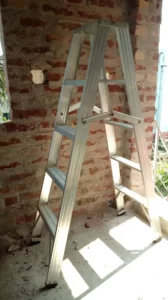Before buying a ladder for use, there are a bunch of things to consider. One of which is the safety of everyone who might use the ladder. One thing however that does not receive a lot of attention but still is very crucial to ensuring ladder safety is the conductivity of ladders.
If you work in the manufacturing industry and have a need to reach high places while working, buying a ladder that is not only sturdy and efficient but also guarantees safety in any manufacturing situation is important.
To prevent any accidents in your workplace, it would be in your best interest to be properly informed of the specifications on each of the ladders available to you. You must be informed about the kind of material it is made of, its load capacity, its durability, and so on.
Are Aluminum Ladders Conductive?
One of the most popular ladders used in the construction or manufacturing industry is the Aluminum ladder. This is for good reason too.
Aluminum ladders possess many qualities that make them the best choice for industrial work areas. Some of these qualities include; lightweight, durable, affordable, impressive load capacity, high material strength, etc.
However, we are only concerned with the one quality that makes it unsafe to be used in industrial work areas; its conductivity. And so the answer to the question are aluminum ladders conductive is yes.
Why are Aluminum Ladders Conductive?

The main reason why aluminum ladders are very conductive is because the ladders are made solely with aluminum which is a highly conductive metal and also as a result of the tightly held atomic structure of these metals. This structure allows for the easy movement of electrons from atom to atom.
Additionally, aluminum has free electrons that move within it even before the introduction of a charge. This makes aluminum a superconductive material, and by extension aluminum ladders.
Aluminum ladders are excellent thermal and electrical conductors. Its thermal conductivity is only evident when your aluminum ladder is in direct contact with a very hot substance. This may not become dangerously lethal in most cases as it takes time for every part of the ladder to conduct dangerous levels of heat. However, its electrical conductivity is a different ball game.
Why is it Dangerous to use Aluminum Ladders for Electrical work?
Simply put, using your aluminum ladder for any electrical work can result in an electrical accident or electrocution. This could eventually become fatal if proper care is not administered immediately.
You may be wondering how these electrical accidents or electrocution may happen. You run a high risk of electrocution if you;
- Use a metal ladder-like aluminum ladders or wooden ladders that have been fitted with metal rods around any loose electrical wiring
- Use a non-conductive ladder like a fiberglass ladder on uneven ground with an overhead electrical wire present. This could cause you to slip and come in contact with the overhead electrical wire
- Touch any conductive ladder that has come in contact with a loose electrical wire
Related: Are aluminum or fiberglass ladders better?
How to prevent Electrocution while using Aluminum ladders
If you must use an aluminum ladder while carrying out any electrical work, there are some measures that you must take to lower the risk of any electrical hazard.
- Ensure the aluminum ladder you intend to use is properly clean and dry.
- You must carefully assess the surroundings to be sure of the location of any overhead wire present before proceeding to use the ladder. If there is any power line present, you must be careful enough to completely avoid it because power lines are capable of causing metal ladders or wet wooden ladders to conduct electricity. It is important to note that although some power lines may be coated, you must still avoid it as these coatings are to increase the lifespan of the power line, not to prevent electrocution.
- When carrying the ladder or moving it, make sure it is as low as possible to avoid the ladder getting entangled with an overhead electrical wire. If it’s a long ladder, you may require the help of an assistant in bringing it down to move it.
- Do not climb up the ladder or use it on a very windy day. The reason for this is simple. A simple gust of wind could result in the ladder shifting and touching an electric wire.
- Position the ladder properly and ensure it is not placed in a way that it could slide to a power line. Ensure you position the ladder at a distance that is far away from any electrical wire (a distance that is twice the length of the ladder is preferable).
- Ensure the ladder is placed on even, solid ground before proceeding to climb it. If this is not the case, you can place a wooden covering over the area, or fill the area with other materials to ensure it is stable enough before mounting the ladder. These wooden materials used to even the floor should be dry and strong to prevent conductivity or any fall accidents.
- If during use or before use, you notice that the ladder has begun to fall or shift into an overhead power line, let go of the ladder immediately. You must never try to touch, hold or move a ladder that may have some contact with an electric wire. Also, you should not leave the ladder in that situation unattended so as not to set a trap for unsuspecting passersby to touch it. Reach out to the power company immediately and request that the electricity on that power line should be cut off temporarily to enable you to move the ladder without any harm.
In Conclusion
If someone has fallen victim to electrocution and is still holding the ladder while it is in contact with an overhead power line, do not attempt to detach them from the ladder with your bare hands as this may also lead to you becoming electrocuted. Instead, use an object made with a non-conductive material like a piece of rope or dry wood.
Joseph is the owner of LadderGeek. He is a home remodeling enthusiast. He has created this blog to share some of his knowledge on Ladder and accessories.



